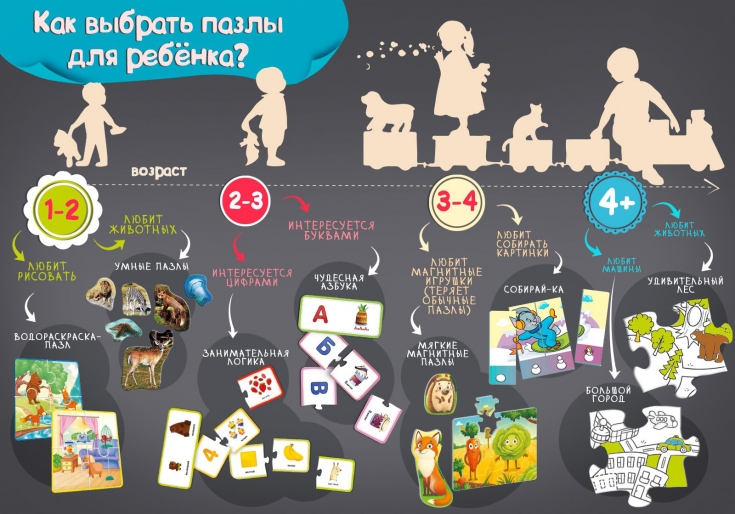Child development is based on learning through play. While playing, the baby easily and quickly memorizes a huge amount of information, thus improving memory and imagination.
The number of games that develop many abilities of the crumbs include children's puzzles. This is a great puzzle game for both boys and girls.
By assembling a cut-up image of an animal or a favorite cartoon character, they develop many skills that will be useful to them in school and in adult life.
How exactly this educational toy affects the child, estet-portal.com will tell you.
1. Children's puzzles contribute to the development of attention and memory
2. Develop logic and spatial orientation
3. Develop fine motor skills and coordination of movements
4. They form and develop imaginative thinking and fantasy
5. Trains the ability to see the problem multifaceted
6. Children's puzzles develop communication skills
Children's puzzles contribute to the development of attention and memory
At the age of 6-12 months, the baby actively explores the environment through sight, hearing and touch.
Despite the fact that he is not yet able to assemble children's puzzles, he enjoys watching his parents do it.
Thus, he develops attention. And watching the bright elements of the educational game, the child learns and remembers the colors.
When the kid grows up and can pick up puzzles himself, while playing, the image of the picture to be made will be held in his head. All this trains the memory.
Develop logic and spatial orientation
At the age of 1 to 1.5 years, babies become more independent. Therefore, during this period they are able to assemble children's puzzles with their own hands.
At first, invite your baby to collect the simplest picture, consisting of 2-3 large fragments.
If you give your baby a puzzle with many small pieces, he may accidentally swallow one of them.
Playing, the child gets acquainted with different parts of the same image. And by helping him put them together correctly, you thereby contribute to the development of his spatial orientation and logical thinking.
Develop fine motor skills and coordination
At the age of 1.5 to 3 years, fine motor skills of fingers and hands actively develop in children. Therefore, children's puzzle will come in handy.
This game consists of several parts, which means that in order to assemble them into a single whole, you need to control them. And this, in turn, develops the motor skills of fingers and hands.
When assembling the puzzle, the movements of the child's hands become precise and meaningful. When the kid goes to school, this will help him learn to write faster. In addition, there will be no problems with handwriting and speech.
By the way, in addition to a paper or cardboard puzzle, you can offer your child wooden insert boards. Collecting such a puzzle, the kid will master the understanding of the relationship of the figure with its outline. But the number of fragments of such a game must not exceed 24.
Form and develop imaginative thinking and fantasy
At the age of 3 to 6, children become inventors. During this period, they actively create various figures.
Even if there is no puzzle pattern before their eyes, they invent something of their own, and without the help of adults. At the same time, the game develops their logic, and also forms imaginative thinking and imagination.
To assemble a picture from fragments, you need to find suitable elements. To do this, the baby imagines them in his head.
And in order to to visually represent the whole picture, he connects his rich imagination. At this age, the optimal number of pieces children's puzzle is no more than 50.
Trains the ability to see the problem in many ways
In order to correctly assemble the children's puzzle, it is necessary to take into account such factors as the shape of the fragment, the depicted object, the sequence of assembling the individual elements and the final result of the game.
All this contributes to the fact that the baby sees the task from different angles. But the multifaceted vision of a particular task – a quality that will certainly come in handy in the future.
So, when solving a certain problem, the child will be able to choose a strategy for solving it, and not concentrate solely on on one option.
Children's puzzles develop communication skills
At the age of 6 to 10 years, it is sometimes impossible for one participant to assemble a puzzle game with complex elements. Therefore, other participants join the game.
These could be friends or relatives. The joint solution of one task makes the child more sociable, especially if he is closed in himself, shy and not sociable.
Child psychologists say the following: if parents assemble puzzles together with the baby, close family relationships are built between them and the baby.
By putting together one puzzle, the child learns to work in a team, help others and achieve the goal, despite the difficulties.
All these skills will be needed in the future, in the personal and professional sphere of life.
And that's not all that children's puzzles are capable of. Such a mosaic makes a child diligent, patient, independent and accurate.
In addition, it develops mathematical thinking, if the baby has the inclinations for mathematics, and also opens up creative abilities in the child.
You can easily arrange joint family evenings with your child, where together with him you will collect an entertaining picture, thus developing the intellectual and physical abilities of your baby.
Such a game will surely bring great pleasure to both your child and you.
How to instill in your child a love of reading fiction books
You might be interested in: Abs Workouts in our video.







Add a comment